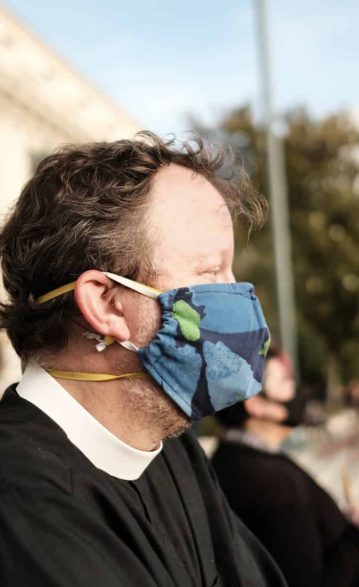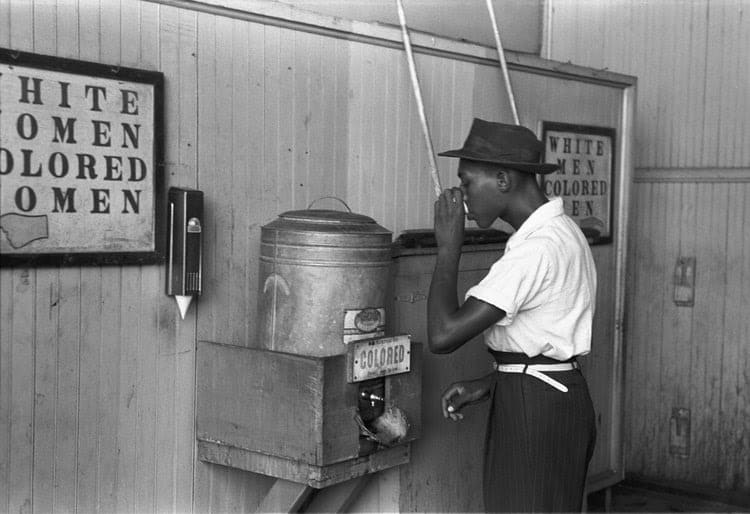Questions for Christians
- Why is nonviolent struggle an essential part of pursuing racial justice?
- How do nonviolent movements for racial justice fit within our participation in the mission of God?
- How does the gospel connect nonviolent movements for racial progress and Christian faithfulness?
Overview
Throughout the Christian scriptures, God is depicted as One who sees and disrupts systems of oppression. In the Book of Exodus, God told Moses: “I’ve clearly seen my people oppressed in Egypt. I’ve heard their cry of injustice because of their slave masters. I know about their pain. I’ve come down to rescue them…” (Exodus 3:7-8). The Hebrew prophets convey that God expects the people of God to see and confront systems of oppression and injustice in their societies as well (Psalm 82:3-4; Amos 5:24-25; Micah 6:8). They confronted the injustices of their world through dramatic performances to communicate God’s displeasure with economic inequality, violence, and government corruption (Isaiah 5:8; Micah 3:9-10; Amos 5:11). They represented God-in-protest of the politics of oppression. Freedom fighters throughout history have been continuing in that prophetic tradition by confronting systems of oppression through the newer strategies of nonviolent civil resistance.
Civil resistance (also known as nonviolent struggle) is a way to confront social oppression directly without the use of weapons or causing physical harm to one’s oppressors. Although the roots of nonviolent civil resistance strategies go back centuries, as early as the Roman empire, nonviolent resistance techniques only began to become perfected and widely adopted in the twentieth century. We owe much of our knowledge about the efficacy, principles, and dynamics of nonviolent civil resistance to the Black Church, who relied heavily on these techniques in their struggle against Jim Crow segregation in the American South. In the philosophy and practice of nonviolence, to quote theologian Walter Wink, Black Christians found a method that showed “oppressors can be confronted without being mirrored.” Ever since the Jim Crow system collapsed because of largely faith-based civil resistance, oppressed people from around the world have looked to the Civil Rights Movement as a testimony to what can happen when ordinary people organize themselves to confront oppressive systems.
It only takes 3.5% of a population engaging in sustained nonviolent resistance to successfully oust an oppressive regime. (Why Civil Resistance Works by Erica Chenoweth and Maria J. Stephan)
Nonviolent movements have proved to be about twice as successful as armed struggles. According to one study, armed struggles have a 26 percent chance at success, while nonviolent campaigns have a 53 percent chance. (Why Civil Resistance Works by Erica Chenoweth and Maria J. Stephan)
Countries that experience nonviolent resistance show a 40% chance of becoming democratic and a 28% chance of civil war. In contrast, revolutions achieved through arms have a 5% chance of becoming democratic and a 43 % chance of descending into civil war within 10 years. (Why Civil Resistance Works by Erica Chenoweth and Maria J. Stephan)


Why it matters
Hillard Brooks had already paid his bus fare but, because he was a Black man, the driver ordered him to exit the bus and reboard through the rear entrance. Mr. Brooks asked for a refund, opting to walk instead, but the driver refused. When it was clear Mr. Brooks wouldn’t leave without his bus fare, the driver called out to a nearby police officer for backup. Law enforcement offers grabbed Mr. Brooks, dragged him to the front of the bus, threw him down the steps, and fatally shot him.
Tragic stories like Mr. Brooks’ murder were all too familiar to Black residents of Montgomery, Alabama, during the Jim Crow Era. Black residents grew tired of being treated with contempt and violence on a regular basis. Shortly after the arrest of Rosa Parks for refusing to give up her bus seat to a white passenger, local Black leaders, including NAACP organizer E.D. NIxon and Jo Ann Robinson of the Women’s Political Council, convened a mass meeting at Dexter Avenue Baptist Church, run by a young reverend new to Montgomery by the name of Martin Luther King, Jr., to begin planning a one-day bus boycott for December 5, 1955.
When 90% of the Black community joined the boycott, the organizers founded the Montgomery Improvement Association to expand the action into a campaign for racial justice. After a year of protest, the U.S. Supreme Court ruled against segregation on public buses.
The Montgomery Bus Boycott made Rev. Martin Luther King a national figure in the Civil Rights struggle and solidified his commitment to nonviolent civil resistance. In his essay “Pilgrimage to Nonviolence,” King wrote: “I came to feel that this was the only morally and practically sound method open to oppressed people in their struggle for freedom.”
Over the past century, nonviolent revolutions have looked to the praxis of the Black pastor-activists who led the Civil Rights movement for inspiration and insight for their own struggles for justice and equality. Nonviolent struggle has proven to be the primary way that oppressed people get free.

What you can do
Personal Actions:
Choose your arena of struggle. It’s important for individuals to choose an aspect of racism they want to work against. Racism is too pervasive a social problem for someone to fight all at once. It can be expressed through economic stratification, policing practices, educational curricula, media representation, immigration policy, healthcare, housing, and of course theology. Each of these systems are so vast and complex, it would take all of one’s mental capacity to understand the foundations and keep up with ongoing developments in each area. This is why would-be faith-rooted freedom fighters would do well to prayerfully discern what their arena of struggle will be.
- Know your role. There are many ways to participate in movements for racial progress. Everyone does not do the exact same type of work. For example, in the Civil Rights Movement, the NAACP focused on pushing forward specific legislation while the Student Nonviolent Coordinating Committee (SNCC) focused on disruptive actions. Activist Daniel Hunter identifies 4 archetypes for movement roles in his book Building a Movement for Ending The New Jim Crow. This list is far from exhaustive, but it gives an idea of the different types of work that need to be done in movements.
- Helpers: These are people who play supporting roles to movement leaders. Most people involved in movements will fit into this role. Helpers cover a broad range of necessary tasks to move the work forward. Helpers do things like bring water to a demonstration, volunteer to make phone calls, collect email addresses, etc. They also may be more involved in providing direct support to other individuals.
- Advocates are people who work within the system for change, such as elected officials, professors, or civil rights attorneys.
- Organizers work outside of established political channels for change. They may build independent movement organizations to push for the necessary changes in their arena of struggle, or they may just bring their neighbors together in a more grassroots sort of way.
- Rebels are the protest leaders. They are folks on the front line of the protest, the ones with the bullhorn in their hand. They bring daring energy and courage and push the movement to expand its creative imagination for constructive disruption.
- Educate yourself. Learn everything you can about the arena of struggle you’ve been called to so that you can fulfill your role in the movement in an informed way. It’s also important for movement participants to educate themselves specifically on the dynamics, principles, strategies, and stories of successful nonviolent struggle. For instance, if you feel called to push for alternatives to incarceration, compile a reading/viewing list of sources on mass incarceration, alternatives to incarceration, and nonviolent struggle. Commit the relevant facts of nonviolent resistance and your arena of struggle to memory.
A Short-term Action: Take This Primer on Civil Resistance
- How to Build a Nonviolent Movement in Under 45 Minutes from CANVAS
- The Secret to Effective Nonviolent Resistance by Jamila Raqib
- The success of nonviolent civil resistance: Erica Chenoweth at TEDxBoulder
A Long-term Action: Join an Organization
It’s imperative that freedom fighters not work alone. The power to change society is in community. Find an organization in your arena of struggle with clear vision, a credible plan for change, and whose values are aligned with yours and volunteer with them. Some people may find that they want to work for or start a movement organization. That works too. Your commitment to educate yourself on your arena of struggle and nonviolent resistance will give you insight into what group is right for you.
Here are some organizations to consider joining or supporting:
“Give justice to the lowly and the orphan;
maintain the right of the poor and the destitute!
Rescue the lowly and the needy.
Deliver them from the power of the wicked!”
Psalm 82: 3-4

If You Think Only Jesus Can Do Something About Racism, You’re Wrong
By Andre Henry
If I had a dollar for every time I heard a Christian say those words, I’d never run out of laundry money. Although the argument is a mere two sentences, it aptly summarizes why many Christians are no help in the pursuit of racial justice, and it is loaded with a myriad of bad ideas—an impressive accomplishment for 11 words.

The Only Justice for George Floyd Is to Finally Abolish Slavery in the U.S.
By Andre Henry
“I can’t breathe,” he pleaded. For several minutes, George Floyd lay handcuffed and pinned to the ground by a white Minneapolis police officer kneeling on his neck.
“Please,” he begged.

Resources for Nonviolent Civil Resistance
Compiled by Lauren Grubaugh and Andre Henry
Our hope is that these practical and empowering resources/action ideas will give you the courage and insights you need to fight systemic racism (and other societal ills).
Additional Resources
- 198 Methods of Nonviolent Resistance (Gene Sharp)
- Rules for Revolutionaries: How Big Organizing Can Change Everything by Becky Bond and Zach Exley
- Beautiful Trouble: A Toolbox for Revolution assembled by Andrew Boyd
- Emergent Strategy: Shaping Change, Changing Worlds by adrienne maree brown
- Unapologetic: A Black, Queer, and Feminist Mandate for Radical Movements by Charlene Carruthers
- This Is an Uprising: How Nonviolent Revolt Is Shaping the 21st Century by Mark Engler and Paul Engler
- Blueprint for Revolution: How to Use Rice Pudding, Lego Men, and Other Nonviolent Techniques to Galvanize Communities, Overthrow Dictators, or Simply Change the World by Srdja Popovic
- Faith-Rooted Organizing: Mobilizing the Church in Service to the World by Alexia Salvatierra and Peter Heltzel
- The ‘3.5% rule’: How a small minority can change the world
- Pillars of Power
Check out our “Breaking the Cycle of Racism” webinar series, featuring Racial Justice program manager Andre Henry with the following guests:
- Micky ScottBey Jones on How We Work for Lasting Change
- Lauren Grubaugh on The Tools of Non-Violent Struggle
- Zach Hoover on Thinking Strategically about Disrupting Racist Systems
